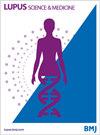Burden of systemic lupus erythematosus in clinical practice: baseline data from the SLE Prospective Observational Cohort Study (SPOCS) by interferon gene signature
IF 3.7
2区 医学
Q1 RHEUMATOLOGY
引用次数: 0
Abstract
Objective The longitudinal Systemic Lupus Erythematosus Prospective Observational Cohort Study (SPOCS) aims to assess SLE disease course overall and according to type I interferon 4 gene signature (IFNGS). Here, we describe SPOCS patient characteristics by IFNGS and baseline disease activity. Methods SPOCS ([NCT03189875][1]) is an international study of patients with SLE according to Systemic Lupus International Collaborating Clinics (SLICC)/American College of Rheumatology (ACR) criteria. Enrolled patients from 135 centres in 8 countries were followed biannually for ≤3 years from June 2017 to November 2022. Baseline demographics, disease characteristics, organ system involvement/damage and flares were analysed descriptively according to SLE Disease Activity Index-2000 score (SLEDAI-2K <10/≥10) and IFNGS status (high/low). Results The study population (n=823) was 93.2% female, with mean (SD) age 45.3 (13.9) years and 11.1 (9.2) years since diagnosis; 52.4% had baseline SLICC/ACR Damage Index score ≥1. Patients with SLEDAI-2K scores ≥10 (241 of 584, 41.3%) vs <10 were younger (mean 42.8 (13.7) vs 46.6 (14.2) years; nominal p=0.001), had shorter SLE duration (10.4 (8.6) vs 12.4 (9.6) years; nominal p=0.012) and more severe flares (12.9% vs 5.3%; nominal p=0.001). IFNGS-high patients (522 of 739, 70.6%) were younger than IFNGS-low patients at first SLE manifestation (30.0 (12.7) vs 36.8 (14.6) years; nominal p<0.001). Proportions of IFNGS-high patients differed according to race (nominal p<0.001), with higher proportions among Asian (83.3%) and black (86.5%) versus white patients (63.5%). Greater proportions of IFNGS-high versus IFNGS-low patients had haematological (12.6% vs 4.1%), immunological (74.4% vs 45.6%) or dermal (69.7% vs 62.2%) involvement. Conclusions We identified key characteristics of patients with high disease activity and/or elevated type I IFN signalling, populations with SLE with high unmet needs. Baseline SLEDAI-2K ≥10 was associated with shorter disease duration and more severe flares. IFNGS-high patients were younger at diagnosis and had distinct patterns of organ involvement, compared with IFNGS-low patients. Data are available upon reasonable request. Data underlying the findings described in this manuscript may be obtained in accordance with AstraZeneca’s data sharing policy described at [https://astrazenecagrouptrials.pharmacm.com/ST/Submission/Disclosure][2]. [1]: /lookup/external-ref?link_type=CLINTRIALGOV&access_num=NCT03189875&atom=%2Flupusscimed%2F10%2F2%2Fe001032.atom [2]: https://www.astrazenecaclinicaltrials.com/our-transparency-commitments/系统性红斑狼疮在临床实践中的负担:系统性红斑狼疮前瞻性观察队列研究(SPOCS)通过干扰素基因特征得出的基线数据
目的 系统性红斑狼疮前瞻性观察队列纵向研究(SPOCS)旨在评估系统性红斑狼疮的总体病程和 I 型干扰素 4 基因特征(IFNGS)。在此,我们按 IFNGS 和基线疾病活动度描述 SPOCS 患者的特征。方法 SPOCS([NCT03189875][1])是一项根据系统性红斑狼疮国际合作诊所(SLICC)/美国风湿病学会(ACR)标准对系统性红斑狼疮患者进行的国际研究。自2017年6月至2022年11月,对来自8个国家135个中心的入组患者进行了为期≤3年的半年随访。根据系统性红斑狼疮疾病活动指数-2000评分(SLEDAI-2K<10/≥10)和IFNGS状态(高/低)对基线人口统计学、疾病特征、器官系统受累/损伤和复发进行了描述性分析。结果 研究对象(n=823)中 93.2% 为女性,平均(标清)年龄为 45.3(13.9)岁,确诊时间为 11.1(9.2)年;52.4% 的基线 SLICC/ACR 损伤指数评分≥1。3%)vs <10分的患者更年轻(平均42.8 (13.7) vs 46.6 (14.2)岁;标称P=0.001),系统性红斑狼疮病程更短(10.4 (8.6) vs 12.4 (9.6)岁;标称P=0.012),病情发作更严重(12.9% vs 5.3%;标称P=0.001)。IFNGS高的患者(739人中有522人,占70.6%)在首次出现系统性红斑狼疮表现时比IFNGS低的患者年轻(30.0 (12.7) vs 36.8 (14.6)岁;标称P<0.001)。IFNGS高的患者比例因种族而异(标称P<0.001),亚洲人(83.3%)和黑人(86.5%)的比例高于白人(63.5%)。IFNGS 高分患者与 IFNGS 低分患者相比,血液(12.6% vs 4.1%)、免疫(74.4% vs 45.6%)或皮肤(69.7% vs 62.2%)受累的比例更高。结论 我们发现了疾病活动度高和/或 I 型 IFN 信号升高的患者的主要特征,这些患者都是系统性红斑狼疮患者,他们的需求尚未得到满足。基线SLEDAI-2K≥10与疾病持续时间较短和复发较严重有关。与 IFNGS 低的患者相比,IFNGS 高的患者确诊时更年轻,器官受累的模式也更独特。如有合理要求,可提供相关数据。根据阿斯利康公司在 [https://astrazenecagrouptrials.pharmacm.com/ST/Submission/Disclosure][2] 中描述的数据共享政策,可获取本手稿中描述的研究结果所依据的数据。[1]:/lookup/external-ref?link_type=CLINTRIALGOV&access_num=NCT03189875&atom=%2Flupusscimed%2F10%2F2%2Fe001032.atom [2]: https://www.astrazenecaclinicaltrials.com/our-transparency-commitments/
本文章由计算机程序翻译,如有差异,请以英文原文为准。
求助全文
约1分钟内获得全文
求助全文
来源期刊

Lupus Science & Medicine
RHEUMATOLOGY-
CiteScore
5.30
自引率
7.70%
发文量
88
审稿时长
15 weeks
期刊介绍:
Lupus Science & Medicine is a global, peer reviewed, open access online journal that provides a central point for publication of basic, clinical, translational, and epidemiological studies of all aspects of lupus and related diseases. It is the first lupus-specific open access journal in the world and was developed in response to the need for a barrier-free forum for publication of groundbreaking studies in lupus. The journal publishes research on lupus from fields including, but not limited to: rheumatology, dermatology, nephrology, immunology, pediatrics, cardiology, hepatology, pulmonology, obstetrics and gynecology, and psychiatry.
 求助内容:
求助内容: 应助结果提醒方式:
应助结果提醒方式:


